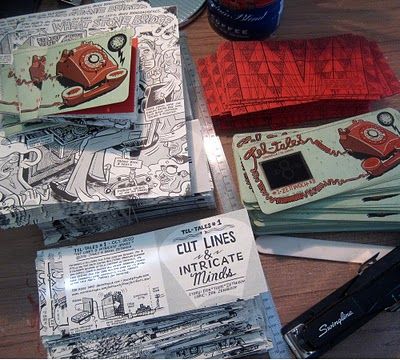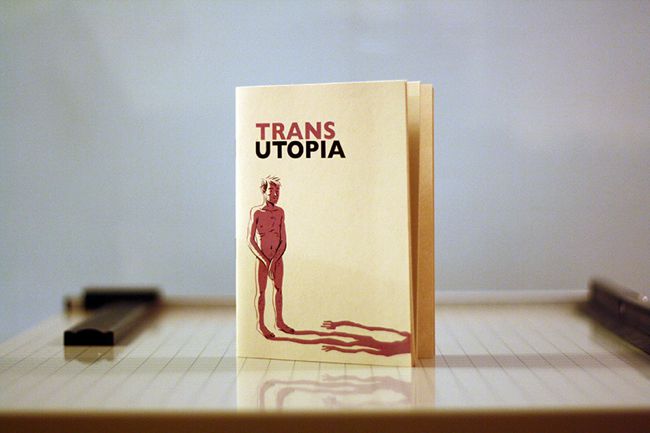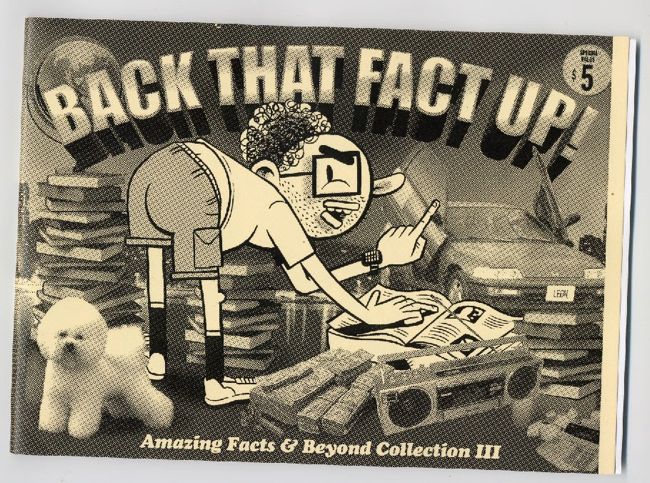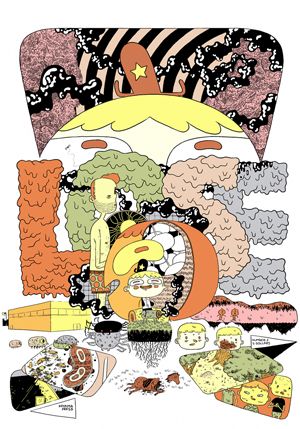When discussing minicomics, I tend to err on the side of being inclusive. As such, my top 25 list of 2010 contains some comics that look like minicomics, but weren't necessarily hand-made. Some were actually produced by small press publishers, like Alvin Buenaventura's new Pigeon Press or Tom Kaczynski's Uncivilized Books. I've also included a couple of lists of broadsheets and single-issue comics, which differ enough in look and feel to think of as something different from but related to minicomics.

1. I Want You #2, by Lisa Hanawalt. Hanawalt in my mind has seized the title of Funniest Cartoonist Alive in a very short span of time. What's remarkable about her work is that I generally am not moved by scatological and gross-out humor, yet this is an essential part of what makes her comics funny. While that's certainly part of her toolbox, there's also the kind of dada logic that makes Michael Kupperman so brilliant, as well as personal and autobiographical details (many of which are incredibly, hilariously gross) and a willingness to go to any logical extreme to tell a joke. Combine that with high-level chops and you've got the must-read cartoonist of the moment for anyone interested in humor.
2. Good Minnesotan #4, edited by Raighne Hogan. Here's my original review. This is a crazily ambitious anthology jammed with midwestern heavy-hitters, comics-as-poetry, comics as art objects, photo-comics, gags and traditional narratives. It's a wonderfully personal & idiosyncratic approach that has only become more accomplished from issue to issue.

3. Diary, by Gabrielle Bell. Bell has become one of favorite autobiographical cartoonists, thanks in large part to her bone-dry sense of humor. This collection of strips published by Uncivilized Books sees her expand her range in surprising ways. Along with a familiar strip about speaking at an art college, there are frank and revealing stories about dealing with depression (that still manage to drop in jokes) as well as an amazing story about the wacky and fictional events that ensued when she volunteered to adapt Valerie Solanos' The SCUM Manifesto for an anthology. Particularly impressive was the way in which she was able to bring this story around to making salient points about feminism and the positive impact of her mother. Bell continues to add sophistication and depth to her graphic presentation as well.

4. Tel-Tales #1, by Dan Zettwoch. A new comic by Zettwoch is always a cause for celebration, and this is one of his best efforts. He's carved out an interesting identity as a cartoonist with his painstaking comics-as-schematic-drawings, where one experiences the page both as a gestalt in terms of its overall impact as well as poring over every last detail Zettwoch crams in. This is a story based on a story told by his father about his days working for the phone company, weaving in the camaraderie of the work place with the technology used at the time. The cover is an old AT&T punch card, adding that extra craftsman's touch that Zettwoch brings to all of his projects.

5. Trans-Utopia, by Tom Kaczynski. This is the latest in Tom K's minicomics series that discuss his relationships with capitalism, America, and his own experience as an immigrant by way of long philosophical and literary digressions. This comic focuses in on 19th-century visions of utopias and dystopias, focusing in on how capitalism fits into the picture. These comics have a pleasantly rambling tone as Kaczynski is in no hurry to get to a particular conclusion even as he's torn as to the consequences of his own actions.
6. Make: Comics About An Intimate Act, edited by Robyn Chapman. Here's my original review. This scatological anthology is remarkably sensitive, beautiful, and funny. Chapman's take is to make public the ways in which our bodies disgust us and use that public discourse to embrace and laugh at our own somatic frailties. That this anthology is also a beautiful, clever art object of its own only makes its appeal broader.
7. Memory Foam 2, by Toby Jones. Here's my original review. Jones is a classic autobio miserablist, a grousing grouch whose saving grace is his hilarious and unsparing sense of humor. He unleashes his animus on everyone, but his favorite (and best) target is himself. Still in the process of finding his voice, he seems to have a great future ahead of him.

8. Back That Fact Up, by Kevin Huizenga & Dan Zettwoch. Yes, Zettwoch is here twice and certainly deserves it. The Amazing Facts And Beyond strip he alternates with the formidable Huizenga for the St. Louis Riverfront Times is remarkably old-fashioned. The idea of an alt-weekly even hosting a regular strip these days is unusual given the state of the industry. This feature is in the tradition of Ripley's Believe It Or Not, only done as (mostly) fake trivia. The cover alone is worth the price of admission, as it features unctuous host Leon Beyond bent over so as to evoke the spirit of the title's pun.
9. Rambo 3.5, by Jim Rugg. Here's my original review. Rugg's work teeters between mainstream and alt-comics, and this mini is an example of him extending in both directions as far as he can go. Employing a dizzying variety of drawing styles from naturalistic to collage, Rugg engages in some inspired silliness in this political parody. At the end of the day, it's just a gag comic, but it's one done with inventiveness and care.
10. Ego #5, by Dunja Jankovic (That links to her site, but I couldn't find this comic available for sale). Jankovic is one of my favorite "immersive-style" cartoonists, one who combines text and image in a gestalt that demands a high level of reader attention. This mini is a collection of short vignettes, each a variation on her painterly/swirling style. Jankovic's focus on neurosis dips into dread, but it's done with an acidic sense of humor. This is a major talent.
11. Salad Days 1, by Minty Lewis. Here's my original review. Lewis's clear line and painfully dry & awkward sense of humor are highlighted here in this story of an anthropomorphic apple who loses his job and tries to figure out what to do next. Lewis is dead-on in the depiction of small humiliations and the ways in which pride leads to them.
12. The Natural World 3-4, by Damien Jay. Here are my original reviews. Jay's jumped into the trend of medieval/fantasy storytelling that a number of alt-cartoonists have embraced, only with a far more original take. This comic has a wonderfully greasy, filthy feel to it—personal, political and sexual issues are all warped for the sake of appearances. Some day, Jay will have his books collected with fancy formatting and get wider recognition.
13. Courtship of Miss Smith, by Alexis Frederick-Frost. Here's my original review. Frederick-Frost combines a spontaneous line, a knack for Victorian-era comedies of manners and an understanding of just how brutal the mating habits of female spiders are into one droll package.
14. Nymphonomena, edited by Betsey Swardlick, Pat Barrett, Josh Kramer, Ben Horak. Here's my original review. The concept for this minicomics anthology is compellingly original: the artists made up a cult movie to write obsessive stories about. The execution is a bit spotty at times, but it's a hilariously original idea with any number of brilliant moments.
15. Annotated #5, by Aaron Cockle. Here's my original review. Cockle's comics have an emotionally labyrinthine quality to them, one where both character and reader are led on a path with no resolution other than one out of Kafka. In this comic, Cockle weds this paranoia-inducing quality with a spy story that slips into apocalyptic storytelling. Cockle doesn't yet have the chops to pull off the visuals needed to tell the story exactly the way he's attempting, but every comic is a bold attempt to do so.
16. L'Age Dur, by Max De Radigues. Here's my original review. These are beautifully crafted, achingly tender and unvarnished expressions of what it's like to be a teen. In a series of ten short minicomics vignettes, De Radigues expresses the oversized and overblown emotions that one links to being young, boiled down to tiny details.
17. Nurse Nurse #6, by Katie Skelly. Here's my original review. Skelly's comics are pulp psychedelia, fusing science fiction with unusual decorative elements. This issue is especially interesting because of the effect Skelly creates with black and white patterns. This series will eventually be collected by Sparkplug Comic Books.
18. Spaz #3, by Emi Gennis. Here's my original review. Gennis is a young cartoonist who mixes autobio, gags, anecdotes, and other ephemera to create a consistently amusing artistic voice, using a style that teeters between cute and crude.
19. Freddy: More Stories, by Melissa Mendes. Here's my original review. Mendes is an increasingly-confident cartoonist who mixes a children's/young-adult book sensibility with vivid, poignant and frequently funny takes on a pre-teen tomboy based on her own experiences.
 20. Just So You Know #2, by Joey Sayers. Sayers is one of the top gagsmiths in comics, but she's changed her focus to writing frequently hilarious and often poignant autobiographical vignettes about her experiences as a trans woman. The gags are frequently a mix between righteous anger and personal relief as she's finally living in an identity that makes sense for her.
20. Just So You Know #2, by Joey Sayers. Sayers is one of the top gagsmiths in comics, but she's changed her focus to writing frequently hilarious and often poignant autobiographical vignettes about her experiences as a trans woman. The gags are frequently a mix between righteous anger and personal relief as she's finally living in an identity that makes sense for her.
21. Everyday, by Joseph Lambert. Here's my original review. Though many of Lambert's comics feature children, they still possess a visceral and often nasty quality. In particular, he has a knack for depicting the unfettered ids of children in a visually exciting manner that combines a childlike simplicity with his formidable chops. This mini was collected in the upcoming I Will Bite You.
22. 2 Eyes Of The Beautiful #2, by Ryan Cecil Smith. Here's my original review. Smith is yet another young cartoonist using the fusion style, here mixing a slightly western take on a Japanese horror story. The way he stretches scenes out and mixes cute drawings with grotesque payoffs is both funny and disconcerting.
23. Stitching Together, by Ed Choy Moorman. Here's my original review. This is a collection of short stories about Jim Henson and the Muppets that carries a surprising emotional punch. Moorman is a talented artist still circling around in finding his voice, but his potential is considerable.
24. Dance After Dark, by Laura Terry. Here's my original review. This is a modestly elegant comic devoted to the depiction of movement in many forms. Terry is becoming increasingly versatile and fluid in her storytelling and is poised to do some great work.
25. Life Of Vice #3, by Robin Enrico. Here's my original review. Enrico is another fusion-style cartoonist who draws heavily from cinema and video games and uses an open-page, panel-free format that allows his images to interact with each other. With a stripped-down style, he uses visceral story elements to creative a narrative about emotions. This comic seemed to focus in on and solve a number of storytelling elements he's been grappling with as a cartoonist.
Five Interesting Broadsheets
The Sunday-style broadsheet has made a comeback as an art object, and the fact that they're cheap to make and look great certainly doesn't hurt. Each of the following takes great advantage of that format, either by keeping it on the cheap with black & white art or going to full color.
1. San Francisco Panorama Comics Section (from McSweeney's #33). The comics done in the McSweeney's/Believer sphere go under-discussed in comics circles. Alvin Buenaventura edits a jaw-droppingly great comics section in every issue of The Believer, and McSweeney's #33 was done in the style of a Sunday newspaper, complete with a comics section consisting of a number of heavy hitters. Like any real comics section, there are some questionable inclusions (the Ian Huebert and Michael Capozzola strips aren't especially inspired), but the good strips are incredible. Dan Clowes' "The Christian Astronauts" is one of the best short stories I read all year; its conceit as part of a continuing adventure makes it a perfect fit for this format, while the grimness of the ending made me miss the short stories Clowes used to do in Eightball. Other highlights include Adrian Tomine's hilarious reimagining of Optic Nerve as a superhero strip, Art Spiegelman's wry take on comics history, a staggering Chris Ware two-page spread, and a typically clever Gabrielle Bell strip. For those not wishing to buy the whole issue, the comics supplement is sold separately.

2. Caboose, edited by Chuck Forsman & Max De Radigues. This is a labor of love by current and former students, fellows and advisers from the Center for Cartoon Studies. It's a jam-packed, 36-page comics newspaper devoted to CCS' home base of White River Junction, Vermont. There's an incredible amount of talent in this paper and a number of approaches, as some artists went the silly route, others delve into bits of quotidian trivia about life in "the Junc" and still others are philosophical about their experiences. Forsman and De Radigues' strips in particular are standouts, as they get to the heart of living in a tiny town as part of an even tinier community of artists. Jose-Luis Oliveres has a funny strip about the students becoming cannibals and eating the brains of the faculty so as to absorb their talent. Alison Bechdel has a fabulous, funny strip about how her skepticism about the whole venture melted away after seeing a talk by Art Spiegelman there, noting "Outside, the town itself resembled a cartoon even more vividly, like the ink of the sky was still wet." A project that could have been in-jokey and self-indulgent instead wound up being warm, well-crafted, and consistently engaging.
3. Pterodactyl Hunters In The Gilded City, by Brendan Leach. Here's my original review. Leach is clearly influenced by a number of artists, including Ben Katchor and David Mazzucchelli, but this is a delightfully rendered account of a past history that included the threat of pterodactyls in New York City around the turn of the 20th century. A taut story that emphasizes the fading away of old customs and ways of life.

4. The Enquirer Dharbin, byDustin Harbin. I've been a little slower than some to embrace Harbin's work, because while he's got great chops, he's a bit quick to rely on fart jokes and basic scatological humor without a larger or more interesting context. This beautifully designed, full color comics "supplement" is a showcase for his talents, zipping between clever autobiographical comics, gags about elephants and a relentless series of strips about being kicked in the balls that wore me down and made me laugh by its end. Harbin's just now beginning to harness his talent and this is proof that he's starting to take his work seriously.
5. You Can't Be Here, by Nic Breutzman. Here's my original review. Breutzman has a real knack for depicting teenage, suburban alienation. There's a real ugliness at the center of his comics, as he tries to get at dark secrets and tiny moments of redemption. This story will be reprinted in a different format as part of an anthology.
Three Regular Size Comics I Liked
I thought I'd include three standard-size comics I happened to enjoy quite a bit, in the spirit of celebrating short-form, small press comics.
1. 1-800-MICE #5, by Matthew Thurber. Here's my original review. Thurber is one of the best cartoonists working today, period. His comics certainly fall into fusion category, but in addition to the humor, craft, and craziness one would expect from such stories, he also injects an intelligence into the proceedings that's matched by few cartoonists.
 2. Lose #2, by Michael DeForge. 2010 was a breakout year for young DeForge, and his comics more than live up to the hype he's garnered. He's one of the most accomplished of the many cartoonists working in the fusion style, and his approach is far more sophisticated than most. First off, his sheer chops are miles ahead of most of his peers, which enables him to try almost anything and make it work. He doesn't just fuse standard genre concerns with an alt-comics sensibility; instead, he puts the entirety of comics culture along with many outside influences into a blender and creates a dread-suffused, visually intense set of stories with a pitch-black sense of humor. Next month's column will focus on his work in greater detail.
2. Lose #2, by Michael DeForge. 2010 was a breakout year for young DeForge, and his comics more than live up to the hype he's garnered. He's one of the most accomplished of the many cartoonists working in the fusion style, and his approach is far more sophisticated than most. First off, his sheer chops are miles ahead of most of his peers, which enables him to try almost anything and make it work. He doesn't just fuse standard genre concerns with an alt-comics sensibility; instead, he puts the entirety of comics culture along with many outside influences into a blender and creates a dread-suffused, visually intense set of stories with a pitch-black sense of humor. Next month's column will focus on his work in greater detail.
3. Blammo #6, by Noah Van Sciver. Here's my original review. Van Sciver, through sheer effort, has become a solid, imaginative cartoonist. He's boldly trying to get better in public, and his efforts are really starting to pay off. I'll have more to say about him when I review Blammo #7 in a couple of weeks.






